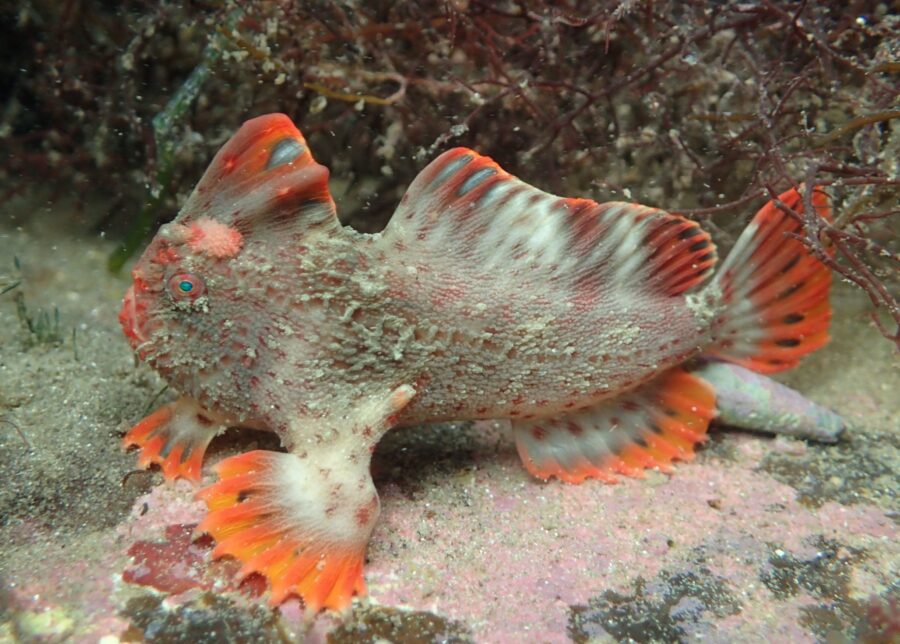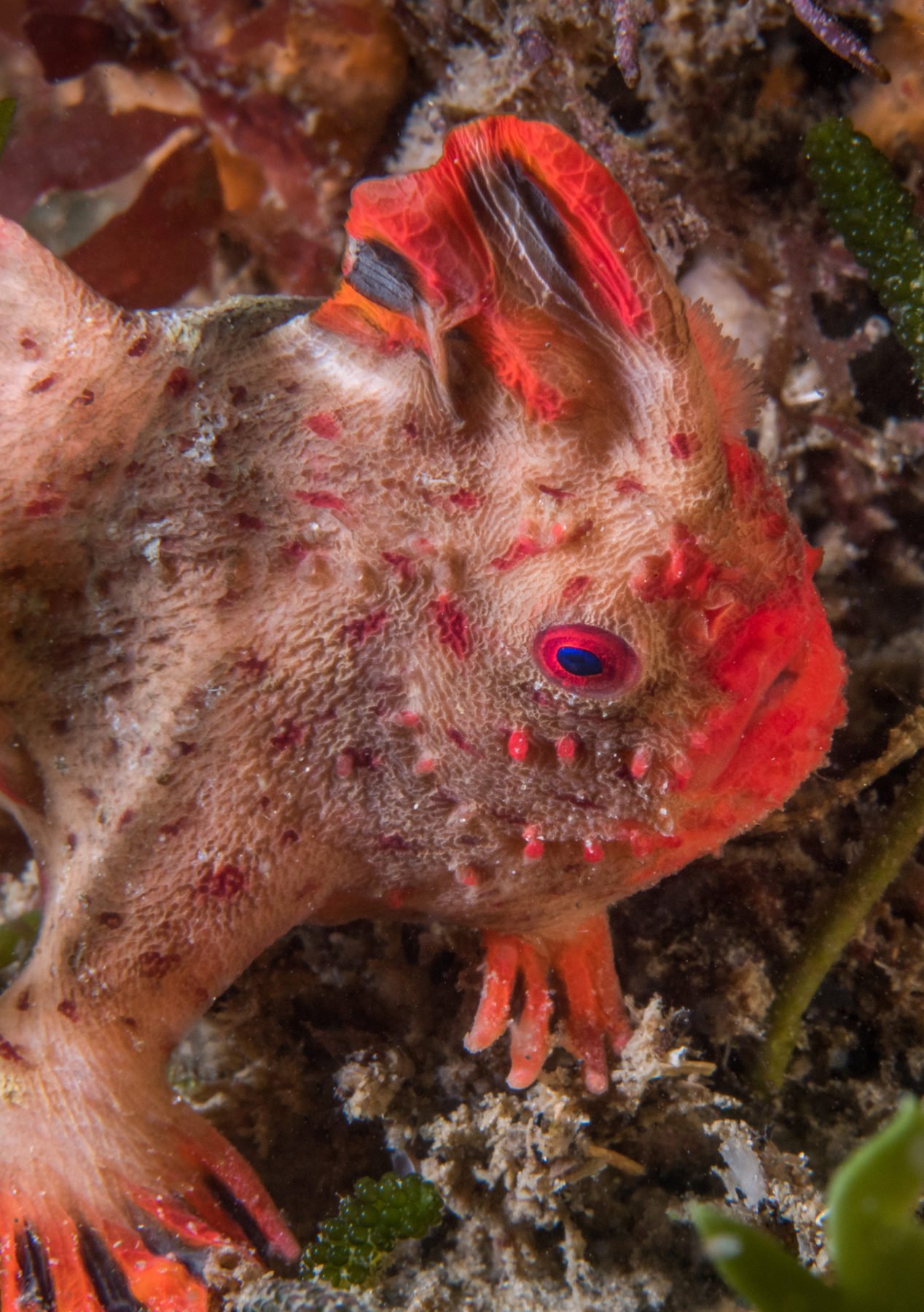‘There’s hope’: Fighting for the future of the red handfish

When marine ecologist Jemina Stuart-Smith organised a small, intimate talk about the red handfish at a local venue in Hobart late last year, she thought only a few people would show. But by the time she was ready to begin, the room was packed. “The local mayor came and the community was engaged and taking ownership of the species and wanted to protect it,: Jemina says. “I think there’s this growing interest in handfish, it does feel like they’re being held up as a flagship species for Tassie threatened marine species.”
This growing interest in Tasmania’s bizarre handfish has increased since the IUCN’s decision to list the smooth handfish as extinct in July 2020. The smooth handfish, not seen for more than two centuries, was the first marine bony fish to be officially listed as extinct. With that listing was an opportunity to turn the spotlight on the other struggling species of handfish.
Australia’s handfish
Australia is home to 13 species of handfish that mostly occupy the southern waters of Tasmania. Of those 13, only the spotted, red and Australian handfish have been seen during the past decade – that it took so long for a fish that hasn’t been seen for 200 years to be listed as extinct is a testament to the rigorous assessment process employed by the IUCN. The National Handfish Recovery Team, where Jemina works alongside 20 other scientists and managers from various fields, lists the red, spotted and Ziebells’ handfish as their priority species.
According to Jemina, the spotted handfish has received the most focus over the past decade due to early recognition of its decline. This work, led by the CSIRO, has involved monitoring and planting artificial spawning habitat and a breeding program where captive-bred juveniles were released back into the Derwent River, their stronghold. However, long-term monitoring of the program has come to a halt due to lack of funding. On the other end of the spectrum is the Ziebell’s handfish, which unlike the spotted and red handfish, hasn’t been seen for more than 10 years, making it difficult to execute any conservation plan. Jemina’s focus is firmly on the red handfish.

The red handfish
In recent times, there’s been some good news about the red handfish. In 2018, divers from the Reef Life Survey marine citizen science program found an entirely new population, which doubled the area they’re known to occupy. However, routine surveys of both tracts of reef, which are just 50 metres long, raised red flags. Sightings became few and far between.
“We had to step in and do something, but like most conservation work, there was no-one to do it and little funding available – but we couldn’t let it go,” Jemina says. “So, we scrambled to get support, I jumped on the recovery team, and we set about implementing an emergency recovery strategy.”
With populations so critically low, there were limited options available. The National Handfish Recovery Team made the difficult decision to replicate the captive-rearing program used for the spotted handfish with an albeit much riskier population of fish. “It was a last resort conservation option. We hadn’t collected eggs or raised them in captivity before and we didn’t know a lot about their biology or ecology. We also weren’t sure about whether those we put back would survive, but we had to take the risk. The alternative was monitoring them until they were gone.”
Drawing on what they learnt from the CSIRO’s spotted handfish breeding program, in 2018 a team of divers collected two clutches of red handfish eggs. They had low hatching success this year, but a handful survived and were housed at Seahorse World in Beauty Point, Tasmania.
In 2019, the team tried once again with new tactics. The CSIRO had observed some unusual spotted handfish parenting methods. They would mouth their eggs and brush them with their hands, so the scientists believed bringing in the females with the eggs could increase the chance of success. But it didn’t go to plan. The females abandoned their eggs – possibly a response to the stress. They were quickly placed back into the wild. Despite this setback, they ended with 71 hatchlings and 52 survivors. “Estimates of their population are less than 100 individuals, so having 52 survive was amazing.”
A future for red handfish
At the end of 2020, the juvenile red handfish were released into the wild. It was tough to wrangle because of COVID, but the day brought ideal conditions for the release. Since then, the Institute for Marine and Antarctic Studies has been monitoring the site of the release. There are mixed results. “It went as well as it could,” Jemina says. “We were diving last week and found one of the juveniles we’d released. But, at one of the sites we’re really concerned about, some days we can spend three hours in the water and find no fish.”
According to Jemina, the captive-rearing program is just one aspect of a swathe of initiatives that need to take place to ensure the future of the red handfish. “The release went well, we’re finding them but we need to improve the process, and have to keep trying to bolster the population.” Habitat management, including removing grazing sea urchins from seaweed – prime handfish habitat, and establishing an insurance population is also on the cards. “They really are on the brink. They occupy very small areas, and a random environmental event could wipe out the whole population and therefore, the species.”
Like the discovery of an all new population back in 2018, the release program has made Jemina and the Recovery Team hopeful. “I think we’ve done so many great things in the last two years and it gives us this glimmer of hope. I think there’s a lot of work to do, but there’s definitely a way forward, and there’s hope.”

